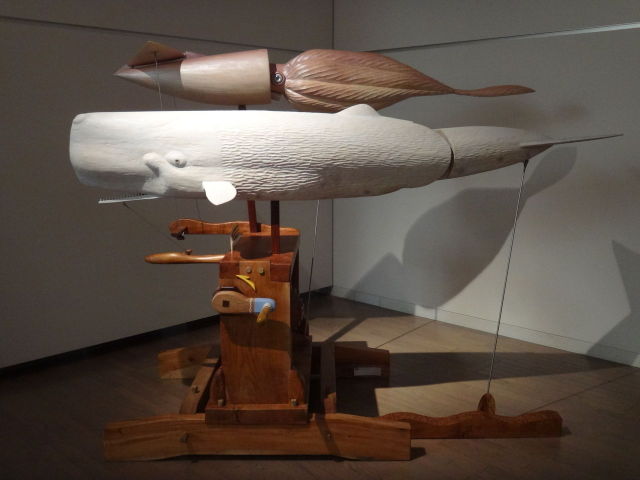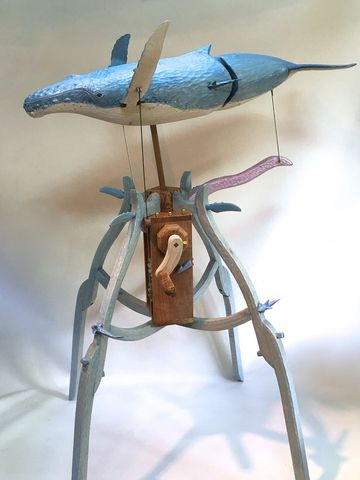Painter, sculptor
and craftsman, gifted with both the ability of designing complex machines and
meticulously reproducing nature, Yutaka Kamiyama is a polyvalent Japanese
artist, active for more than twenty years in a small seaside town near Tokyo.
Great observer of
the marine world, he realizes fascinating kinetic sculptures carved in wood,
inspired by the marine fauna, while teaching painting and crafts in parallel.
His thorough and delicate animal sculptures are in fact complex and ingenious
machines: his marine animals are arranged on carved wooden pedestals that
borrow various forms evoking alternately algae, corals or even the ripples of
water. These structures are equipped with handles to operate the machinery and
animate each real or imaginary marine creature. These kinetic sculptures plunge
the spectator into a dreamlike universe, where a whole aquatic bestiary takes
life, each piece of wood that compose the body of the animal moves
individually. When they are animated, thanks to the action of the handle, we
can witness a strange ballet where the dancers are whales, sailfish, sperm
whales, scorpionfishes or fish of the abyss, floating in the air gracefully,
without truly going anywhere. The poetry that emerges from this spectacle is
further reinforced by the scale changes that these animals undergo: the
sailfish seems bigger than the sperm whale, the scorpionfish as imposing as
the small whale. This game of scale evokes both models of natural sciences and
old elaborate toys and form a playful, educational, accessible and particularly
endearing visual universe.
Made from natural
materials and related to the movement of the body, these animal sculptures
break away from technology and robotics and rather bond with the natural
sciences and wildlife observation. These sculptures explore the dialectic
between the artist, the public and the animal; above all, they question the
links between Man and Nature. Man is indeed a part of the work, in the same way
as the structure of wood and each piece follows its own grammar, as conceived
by the artist: "The main body is carved in wood of hinoki cypress, camphor and
gingko; These woods have a strong symbolic significance in Japan and were used
in particular for ancient Buddha statues. For the plinth and the mechanical
parts, I use a harder wood such as green oak, cherry, elm, chestnut or maple.
Each wood has its own characteristic; their differences can be seen by observing
their color, their perfume, and their viscosity. I am deeply fascinated by
every property of these woods and I see the life of a tree through each piece
of them. Using wood, my intention is also to revive the life of the tree in a
new form.” The approach of resurrection of the living being undertaken by
Yutaka is expressed in the address he shows in his way of imitating animal
gestures.
Each artificial
animal of Yutaka Kamiyama borrows precisely the gesture that his living model
uses to move under the water, thus adding to the impression of realism but also
to the poetry that there is to give a new life to wood, in the form of Animals.
The movement does not generate a shift but reproduces slowlier the way of
moving of each animal, decomposed into mechanical gestures which allows to
appreciate with more intimacy the rhythm of the animal. This decomposition of
the movement evokes the photographs of Jules-Etienne Marey, or Eadweard
Muybridge, who present the prints of each gesture that make up the behavior of
an animal in chronological order to decompose it. Nevertheless, the marine
animals of Yutaka Kamiyama are animated by a real impulse which is not only
suggested by two dimensions; Like the mobiles by Alexander Calder, the machines
of Jean Tinguely, the works of the constructivists or even those of several
digital artists, this movement participates entirely to the identity of the
work. The artist insists on this essential aspect: "I consider that a
piece is complete only when the audience animates the sculpture by operating
the handle. Public participation is an integral part of the work. "Yutaka
Kamiyama aims to make the viewer an actor of his own perception, to lead him
into a dynamic of sensory and semantic enlargement. Each of his sculptures can
be seen as an experience. The action of the handle makes it possible to hear
the crackling of the wood, the squeaks of the mechanisms and the shocks of the
articulated parts, thus creating a unique sound landscape, exploring both the
plastic and music qualities of wood. Unlike traditional art forms where the
interaction between the work and the viewer is primarily a mental event, these
interactive machines multiply sensory experiences and participate in a total
art combining painting, sculpture, scenography and animation.
By combining his
technical and biological knowledge with a subtle and dreamlike poetry, Yutaka
Kamiyama succeeds in reproducing nature by mechanics. This process can remind
of the animated marine animals of Bob Potts, but Yutaka Kamiyama distinguishes
himself from this latter by his use of natural materials and especially by the
meticulousness of his achievements: "I realized the first piece of this
series seven years ago, after my meeting with a sperm whale of 15 meters long,
stranded on the beach near my home. Its size and shape struck me and since then
I have a great interest in marine life and its environment, which I observe for
long hours each day. I am also concerned about its safeguarding and my work
also consists in raising awareness of the crucial aspect of the protection of
marine fauna ". Thus, each marine animal depends on the spectator to
become animated and it is only when the spectator acts that the animal comes to
life. This process makes it possible to become aware of the importance of
individual action in safeguarding marine fauna, whose fragile equilibrium is threathned.
The kinetic marine
fauna of Yutaka Kamiyama was recently presented in Paris at the Salon Art
Shopping 2016, where he exhibited a whale from his bestiary: "It was really
a good experience for me, I had the opportunity to meet people from all over
the world who showed interest in my play.” I myself had the opportunity to
activate it, to feel the wooden mechanisms set in motion and see the animal
come to life in a remarkable way. This experiment as playful as poetic freezes
the time and one can remain for a long time activating the crank while watching
the animal taking life. These pieces will be exhibited at two events in Japan
in 2017: "My biggest pieces will be exhibited during the collective
show" Kokuten ", at the National Art Center in Tokyo in May 2017. I
also plan to show my biggest three-dimensional work during "The 27th UBE
BIENNALE" in Yamaguchi Prefecture, Japan, in August. "
I invite the
reader to visit the site of Yutaka Kamiyama which can be found below, to follow
the evolution of his work and to discover all his kinetic sculptures.
















